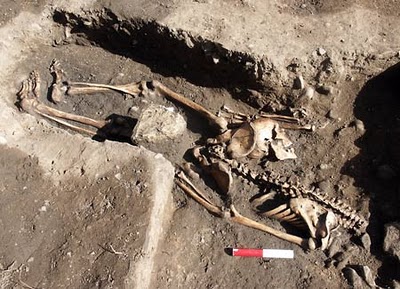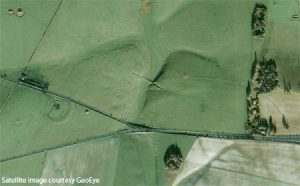 In his article The Iceman as a burial appearing in Antiquity 84/2010, the archaeologist Alessandro Vanzetti of Romes La Sapienza University and his coauthors reconstruct the position of the Iceman at his place of discovery on the Tisenjoch pass in South Tyrol, Italy. From this and based on his botanical investigations, he draws the conclusion that the Iceman did not die at the site of the incident: rather he died in the spring within his valley community and only later, in September, was brought up to the Tisenjoch and buried there.
In his article The Iceman as a burial appearing in Antiquity 84/2010, the archaeologist Alessandro Vanzetti of Romes La Sapienza University and his coauthors reconstruct the position of the Iceman at his place of discovery on the Tisenjoch pass in South Tyrol, Italy. From this and based on his botanical investigations, he draws the conclusion that the Iceman did not die at the site of the incident: rather he died in the spring within his valley community and only later, in September, was brought up to the Tisenjoch and buried there.
The team researching tzi has now responded to Vanzettis claims, in a statement issued by the South Tyrol Museum of Archaeology. They point out Vanzettis scenario has already been discussed numerous times in the past, and say it displays fundamental weaknesses in its chain of argument and its archaeological context , meaning that the hypothesis of a burial on the glacier, is unconvincing.
The conservation and research team does do not regard pollen or the distribution pattern of the associated finds as suitable for analysing the cause of death, the possible body changes after death or the funeral rites.
From an archaeological viewpoint, they say, it should be noted that this body from the Copper Age found on the Tisenjoch represents a unique discovery. South American cultures perform burials on mountains or at altitude, but there are no known comparable cases in the Alpine region. On the contrary, during the Copper Age individual burials in ordinary cemeteries close to settlements were the rule. Even in the case of highly complex funeral rites (individual or collective graves, primary or secondary burials, interment or cremation), there are no indications of burials taking place so far away from settlements.
Regarding Vanzettis ethnohistorical argument that, in Tyrol, the deceased were preserved after death and only carried over the mountain passes to cemeteries after the spring thaw, the archaeologists point out that this can be explained by the system of Christian churches with cemeteries and the feudal power structures of the Middle Ages. In such cases the dead were buried as soon as possible in the appropriate cemetery according to church law. The object was however to bring the dead to the cemetery in the village, not from the village to the mountain. Suggesting an analogy between this Christian era custom of keeping the dead and the burial practices in tzis Copper Age, the team says, is pure speculation.
 If, as Vanzettis article proposes, the Iceman died in a valley location in April and was only carried up the mountain in September, there would be evidence of greater decomposition processes as well as insect infestation, despite any attempts at mummification.
If, as Vanzettis article proposes, the Iceman died in a valley location in April and was only carried up the mountain in September, there would be evidence of greater decomposition processes as well as insect infestation, despite any attempts at mummification.
The research team says there is no proof of these, so we can assume that the body must have lost much by way of fluids but was rapidly frozen and protected by a covering of snow or ice.
This special situation resulted in the mummifying of the Iceman, unique in the world, with the fluids in his tissues remaining preserved. This preservation is based on a freezedrying process and cannot be explained by dry mummification, as Vanzetti conjectures.
The most important forensic evidence for the fact that the loss of body fluid could not have occurred anywhere else than at the place of discovery is the position of the left arm and the uninterrupted stream of blood from the wounded artery via the wound path to the skin. This clearly proves that the position of the arm is as it was exactly at the time of death, while the blood was still circulating. As the corpse lost its rigidity it would have been very easy to lie the arm next to the body.
Vanzettis counterargument is that the body was buried intact on the glacier and that it only slid downwards as the glacier melted, with the arm moving to its current position in front of the chest. This is inconceivable if, as the authors previously state, the Iceman had already died a few months before and been mummified. The rigid arm could then no longer be brought into its position without causing substantial damage either to it or to the shoulder. All of the Icemans joints are in fact in their anatomically correct position. It is therefore not possible for the intact mummy to have been transported up to the glacier.
It wasnt until 2001, prompted by the discovery of an arrowhead lodged in tzi’s shoulder, scientists discovered the Iceman died a violent death. Further research revealed bruises and cuts, as well as evidence the Tyrolean Iceman received a blow to the head.
It is thought to be unlikely tzi was alone on the Similaun mountain at the time of his death possibly his companions have attempted to save him.
The research team (which includes Dr Zinc who worked on the King Tut Unwrapped DNA project) is currently reexamining the glacier mummy and for the first time his DNA. They promise to publish their data analysis as well as the resulting conclusions by next year, in time to celebrate the 20th anniversary of tzi’s discovery.



